Rapaces; definiciones y nuevas especies
Text in English bellow
La definición de lo que se considera una rapaz, puede ser un aspecto muy importante para una especie, esto parece un tema de poca importancia, pero cuando una especie esta en peligro de critico de extinción puede ser determinante para su recuperación o su extinción. Muchas organizaciones solo financian programas de conservación dirigidos a la protección de Rapaces. Lo mismo ocurre cuando una especie en Peligro Critico de Extinción es considerada subespecie de una especie considerada como preocupación menor. Aquí veremos ejemplos de especies que se recuperaron por considerase como rapaces, o por no considerarse una subespecie. La taxonomía puede ser determinante para la conservación de una especie en Peligro Critico de extinción ya que cuando una especie pertenece a las “rapaces” despierta un mayor interés social, que cuando no lo es.
La atención prestada a las especies consideradas como rapaces es alta, no existen criterios establecidos o confiables para excluir o incluir una especie del grupo de las rapaces. El termino de rapaz deriva del latin “Rapt”que significa “agarrar o llevarse” en referencia a la estrategia estereotipada de caza de rapaces de apoderarse de presas. El interés por definir correctamente una rapaz es creciente, durante años se consideran rapaces los táxones incluidos en los ordenes de los Cathartiformes, Accipitriformes Strigiformes y Falconiformes. Aunque con los Cathartiformes el debate fue mayor y algunos autores los cuestionaban como aves de presa (Seibold y Helbig 1995, Tagliarini et al. 2011) y consideraban que debían de incluirse en el orden de los Ciconiiformes.
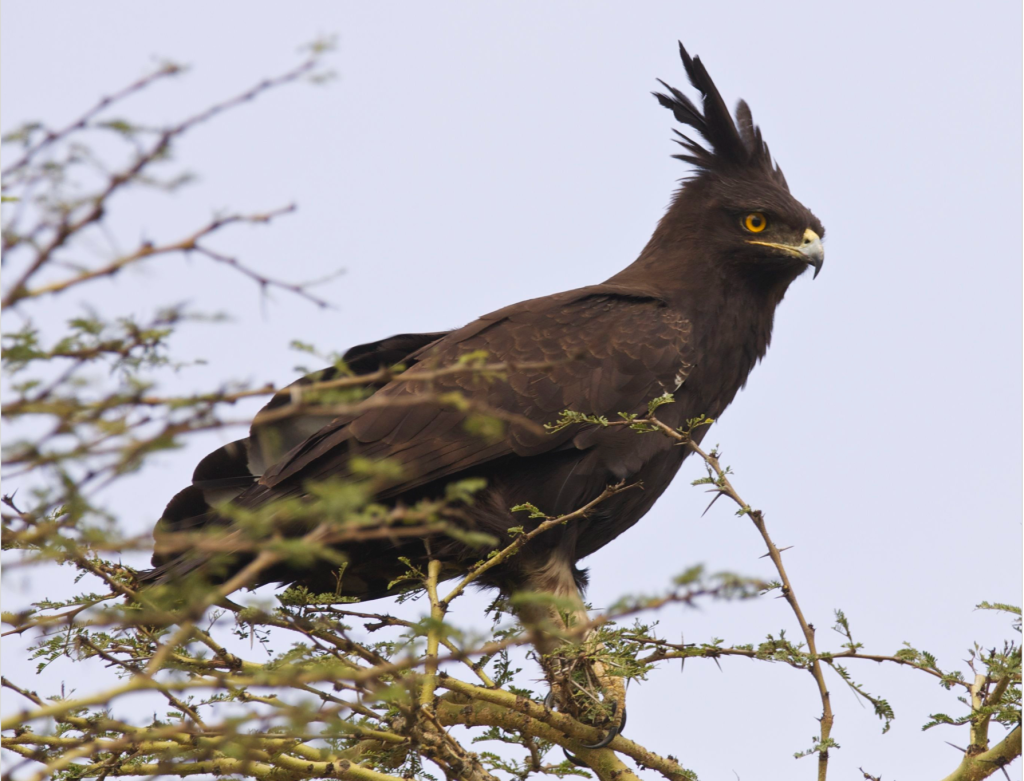
Long-crested Eagle (Lophaetus occipitalis) This species of African bird of prey of the order Accipitriforme, fits the traditional definition of Raptor.
Photography: R. Sánchez 2016 ©
Las rapaces se han definido con frecuencia en vase a su dieta depredadora basada en animales vivos, aunque esta denominación por si sola era demasiado confusa ya que se podrían incluir los passeriformes insectívoros, las gaviotas, o los alcaudones (Lanius) que son predadores e incluso transportan presas con sus pies (Pérez y Hobson 2007, Sustaita y Rubega 2014), por lo que esta definición es muy genérica y se requiere de otra más más precisa. Algunas especies de aves marinas también fueron descritas como rapaces, el págalo grande (Stercorarius skua) y el págalo parasito (Stercorarius parasiticus) por su estilo de vida de rapaces y su dimorfismo sexual, las hembras son mas grandes que los machos también han sido considerados como rapaces (Catry et al. 1999), Sin embargo cómo la definición de las rapaces se limita tradicionalmente a las especies de aves terrestre, las aves marinas fueron excluidas. Por lo tanto, un estilo de vida de rapaces por sí solo no es un criterio exclusivo o preciso para definir las aves rapaces (McClure et al. 2019). Existen también varios criterios basados en la morfología, por ejemplo Bronw (1976) declaró: «Las verdaderas aves de rapiña son aquellas que tienen poderosas patas con garras para agarrar y matar, y picos ganchudos para desgarrar la carne”, para otros autores las aves rapaces , son aquellas con vista aguda para detectar presas, pies con garras afiladas para matar o sujetar y picos en forma de gancho para para matar o consumir presas ( Brown 1971 , Newton 1979 , Bildstein 2017 en McClure et al. 2019).
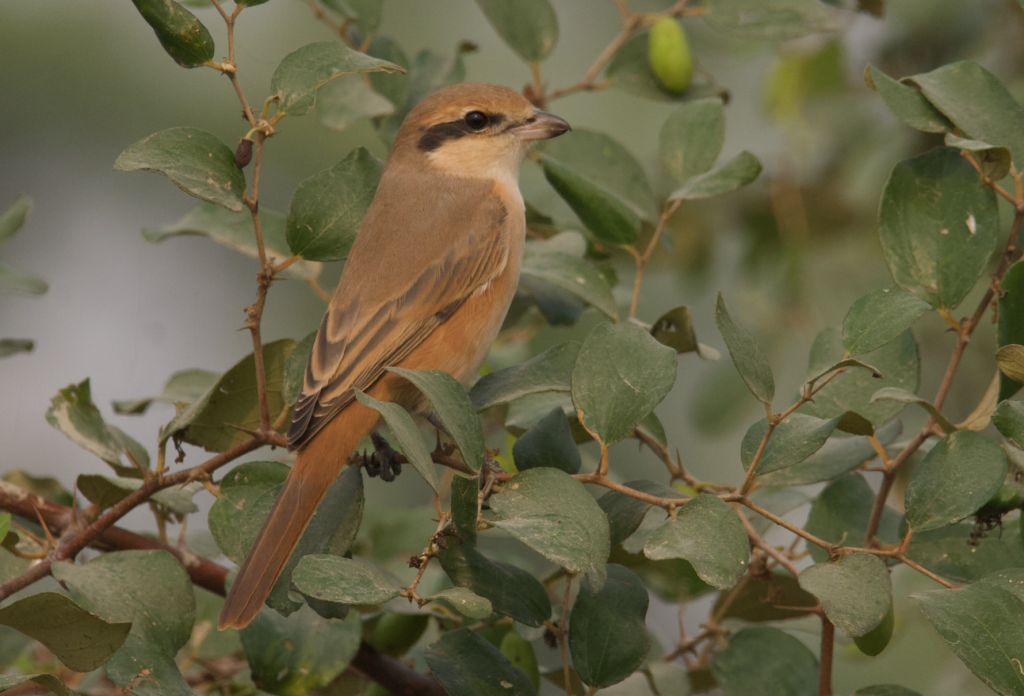
Isabelline Shrike (Lanius isabellinus), the species of the genus Lanius, due to their condition as hunters, have been considered raptors.
Photography: R. Sánchez 2015 ©.
Sobre la agudeza visual de las rapaces ha sido descrita por Newton (1979) y recientemente por Bildstein (2017) como adaptación a la caza. En investigaciones que estudian el comportamiento de la caza y las técnicas de caza utilizadas por algunas especies de rapaces se comprobó que las la mayoría de técnicas estaban basadas en la observación, desde posaderos o desde el aire (Margalida et al. 2017). Algunos de las especies de buitres del viejo mundo tienen la mayor agudeza visual registradas entre los vertebrados, por ejemplo el buitre leonado (Gyps fulvus) que es capaz de detectar carroñas pequeñas a varios kilómetros (datos propios). El águila imperial ibérica (Aquila adalberti), se ha comprobado que un ave territorial es capaz de identificar a un individuo intruso a distancias de entre 5 y 6 kilómetros y comenzar un ataque desde un posadero (datos propios). Sin embargo la agudeza visual no es propio de las rapaces, si no también de otras especies presa, la agudeza visual puede ser también un mecanismo de defensa de las presas para defenderse de los predadores, por lo tanto incluir la agudeza visual en la denominación de rapaces no es un aspecto determinante.
Sobre las patas, poderosas y con grandes uñas “garras” la mayoría de especies las tienen, todas las especies de Falconiformes y de Striguiformes, sin embargo en los Accipitriformes, Sagittariidae carece de esas características y en Accipitridae le ocurre lo mismo a los buitres del viejo mundo. Por el contrario hay otras especies de aves como los Psittaciformes que aunque carecen de uñas afiladas con los pies pueden sujetar la comida u otros objetos, lo mismo ocurre con los alcaudones (Lanius) que son capaces de trasladar grandes presas con ellos, por ello la definición para las rapaces de “pies con garras afiladas para matar o sujetar presas” tampoco es del todo correcta. Algo similar ocurre con el pico, tener un pico fuerte y con forma de gancho no es exclusivo de las rapaces, los ptittaciformes tiene picos con esas características, lo mismo ocurre con los alcaudones (Lanius), por el contrario algunas especies de rapaces sus picos no reúnen esas características, por ejemplo los buitres del viejo mundo, los caracara o el ave secretario no tienen picos con forma de gancho, pero si fuertes y capaces de trocear presas.
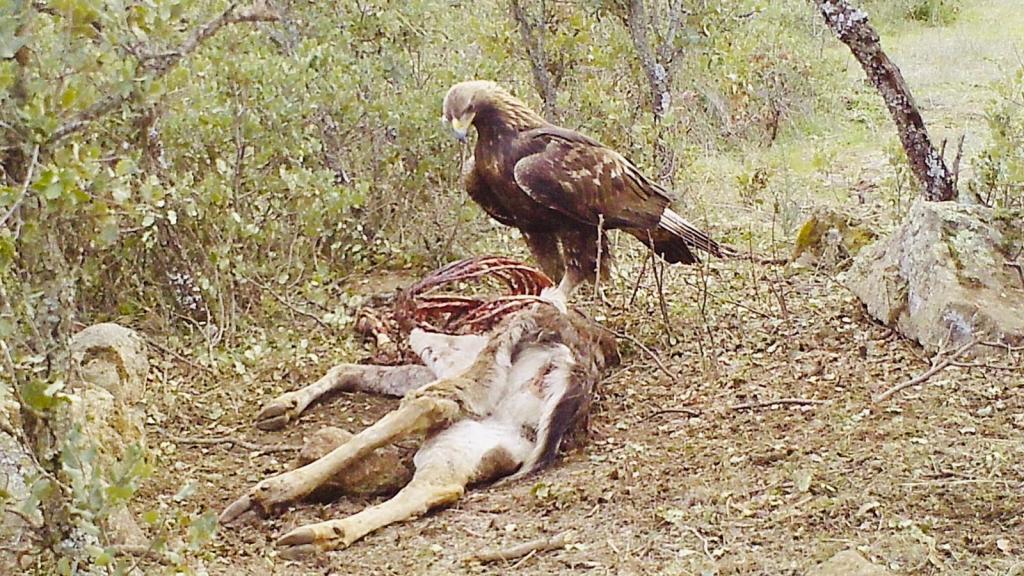
Golden Eagle (Aquila chrysaetos), consuming a carrion in Toledo, Spain. The golden eagle is a species that fits the definition of «killing live prey» however it has been found to feed on carrion more frequently than expected. Photography: Rafael Finat 2021 ©
Sobre “matar presas vivas” tradicionalmente se cree que las águilas son cazadoras y que se alimentan mayoritariamente de presas vivas y que residualmente se alimentan de carroñas”. Cuando se estudio el comportamiento alimenticio del águila imperial ibérica (Aquila adalberti) una especie típica de águila, se comprobó que el carroñeo se uso con mayor frecuencia de lo esperado e incluso que las aves de edades no reproductoras se alimentaban de carroñas muy frecuentemente (Margalida et al. 2017), algo similar ocurrió en España con el águila real (Aquila chrysaetos) se colocaron cámaras trampa en carroñas y se comprobó que accedían a ellas para alimentarse con bastante frecuencia (Sánchez‐Zapata et al., 2010). Sin embargo, otras especies como cuervos (Ej., Corvus corvus, C. corax , C. cryptoleucus) , se pueden alimentar de presas vivas y de carroñas y han sido incluidos en su guía para el estudio y seguimiento de aves rapaces. También hay numerosas especies que cumplen con la características de “matar presas vivas” y sin que se haya descrito el comportamiento de carroñeo, como por ejemplo los alcaudones (Lanius), y las especies de este genero aunque según algunos autores podrían incluirse como rapaces, no están entre los cuarto ordenes reconocidos tradicionalmente como rapaces.
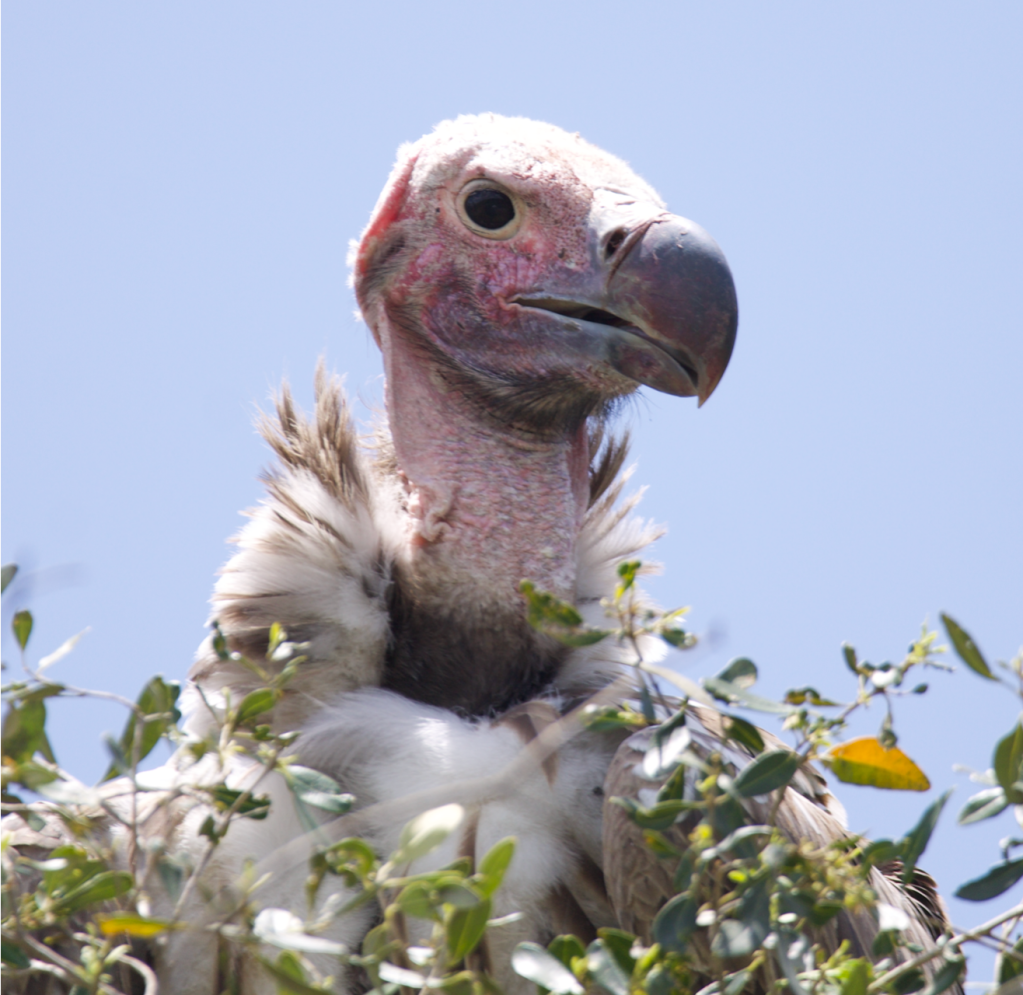
The beak of the vultures, like their feet, do not fit the definition of raptors and therefore their inclusion in the group of raptors has generated controversy.
Photography: R. Sánchez 2016 ©
La clasificación de los buitres como rapaces también ha sido una fuente de desacuerdo. El comportamiento de carroñero obligado de muchos buitres y su falta de garras especialmente afiladas los diferencian ecológica y morfológicamente de otras aves rapaces como halcones, águilas y búhos (McClure et al. 2019). Sin embargo en los últimos años los reportes de buitres matando presas vivas han aumentado, si bien se sigue considerando un comportamiento aberrante y muy posiblemente este relacionado con la escasez de carroñas. Comportamientos similares se han descrito con Buitres del viejo mundo, con el cóndor andino (Vultur gryphus) y con el zopilote negro (Coragyps atratus). Aunque todas estás especies están consideradas como rapaces.
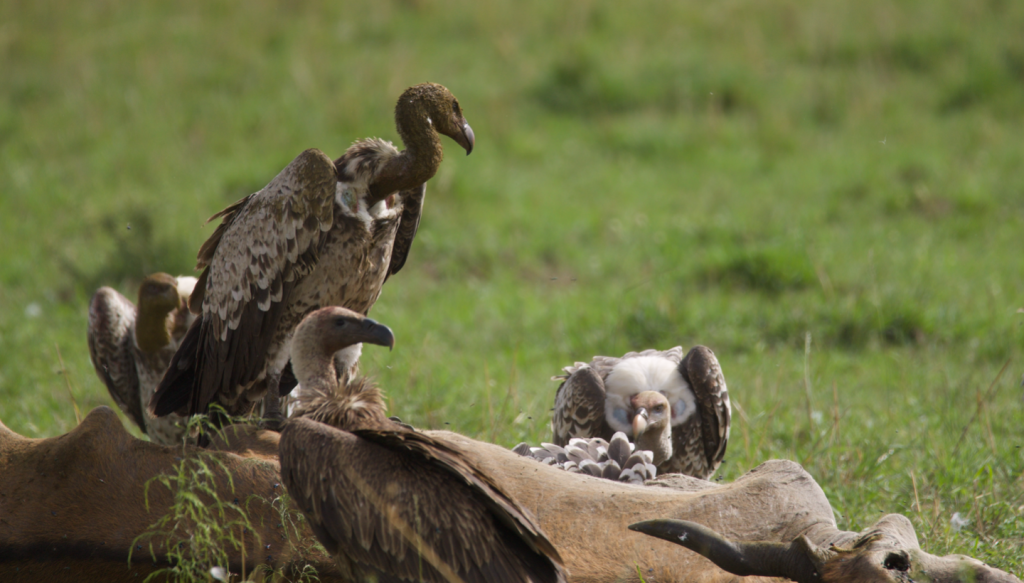
La definición de lo que se considera una rapaz, no es un mero hecho teórico o académico puede ser determinante para la conservación de una especie, para muchas organizaciones dedicadas a la conservación de las rapaces es importante tener claro que especies se incluyen, ya que sus fondos están enfocados específicamente a las rapaces. El Cóndor de California (Gymnogyps californianus) es un claro ejemplo de ello. Se extinguió como especie silvestre y en 1987 todos los cóndores vivos estaban en cautividad. Su declive ya era evidente a lo largo del siglo XX, en 1950 su población se estimaba en 150 individuos, en 1968 se estimaba en 60 aves, en 1978, 30 aves y durante la primera mitad de la década de los 80 se acelero la tasa de disminución (Finkelstein et al. 2020), y entonces se decidió la captura de los pocos ejemplares que aún quedaban en libertad y fueron mantenidos en cautividad en el Zoo de San Diego y en el Zoo de los Angeles (California). Bajo estas dramáticas circunstancias la inclusión de los Cathartiformes como rapaces fue determinante para conseguir financiación y comenzar un ambicioso plan de recuperación que termino por devolver a esta emblemática especie de nuevo a su entorno natural, los intentos por reintroducirlo comenzaron en 1992 en California, en Arizona en 1996 y en Baja California (Mexico) en 2002, actualmente ya se reproduce en California y Arizona. La no inclusión del Cóndor de California como rapaz hubiese provocado su extinción como especie salvaje, posiblemente sí.
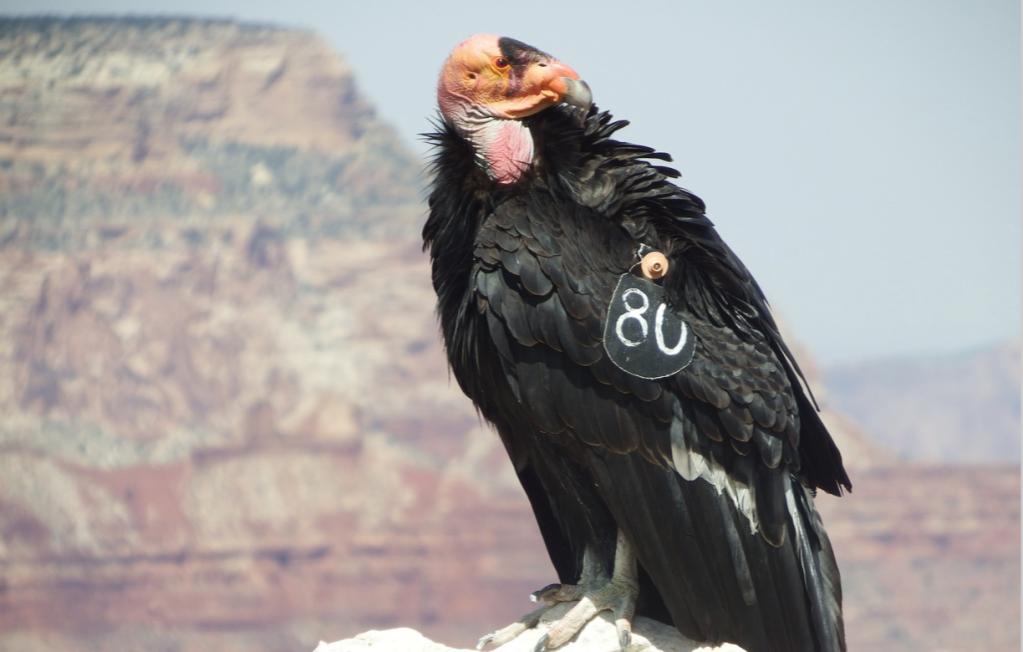
La ultima definición propuesta para las rapaces o aves de presa es, como todas las especies dentro de órdenes que evolucionaron a partir de un linaje de aves rapaces terrestres y en las que la mayoría de las especies mantuvieron su estilo de vida rapaz derivado de su antepasado común (McClure et al. 2019) y basándose en la taxonomía actual estos autores proponen, que esta definición incluya especies de los órdenes Accipitriformes, Cathartiformes, Strigiformes, Cariamiformes y Falconiformes. Por lo que se incluirían dos especies mas a las rapaces y aves de presa, la Chuña patirroja (Cariama cristata) y la Chuña patinegra (Chunga burmeisteri) ambos tienen su rango de distribución en Sudamerica y ambas especies se alimentan de pequeños vertebrados, y morfológicamente se asemejan al ave secretaria ( Sagittarius serpentarius) en dieta, comportamiento y apariencia tanto que seriemas y ave secretaria alguna vez fueron colocados en el mismo orden, entonces el ave secretaria fue incluida en las Cariamiformes.
La Chuña patirroja (Cariama cristata) habita en bosques abiertos, matorrales espinosos y pastizales montañosos. Su gran tamaño, patas y pico rojo brillante y cresta suelta prominente la convierten en una especie visualmente distintiva. Su rango de distribución se enmarca en el C & E Brasil a través de E Bolivia y Paraguay a Uruguay y C Argentina (S a La Pampa), es un ave sedentaria (Gonzaga et al 2020), esta catalogada como especie de preocupación menor y el tamaño de su población se desconoce, su tendencia poblacional se considera estable (Birdlife internacional 2016). Construye sus nidos sobre ramas de árboles con ramas, hojas y material orgánico, pone de 2 a 3 huevos y la incubación es de 30 días, y abandonan el nido en 30 días. Basa su dieta en el consumo de anfibios, serpientes, roedores e insectos.
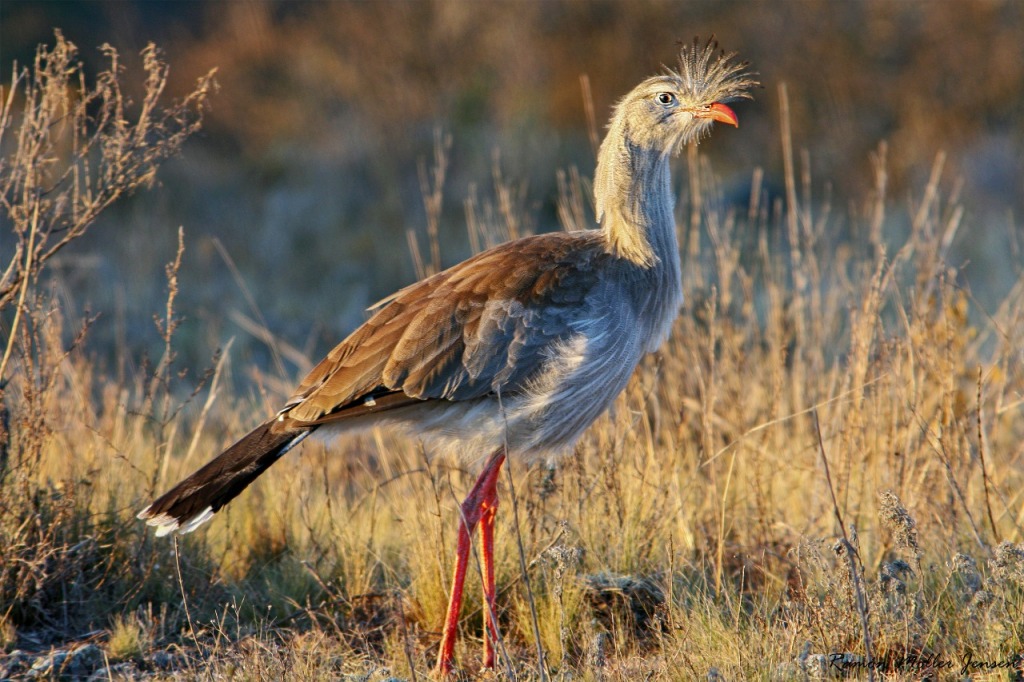
La Chuña patinegra (Chunga burmeisteri) es endémica de la región del Chaco del centro sur de América del Sur, en Bolivia, Argentina y Paraguay. Es un ave muy singular, con un pico corto y curvo, y patas largas y poderosas. Tiene un comportamiento terrestre y es poco voladora, habita en el chaco boscoso, es sedentaria. Esta catalogada como especie de preocupación menor y el tamaño de su población se desconoce, su tendencia poblacional se considera estable (Birdlife internacional 2016). Construye nidos con ramas sobre las ramas bajas de arboles o en arbustos pone de 2 a 3 huevos, sin embargo solo llega a volar un pollo, aunque hay reportes de nidos con 2 pollos, su alimentación esta basada en el consumo de langostas, pequeñas serpientes y pequeños passeriformes (Gonzaga et al 2020).
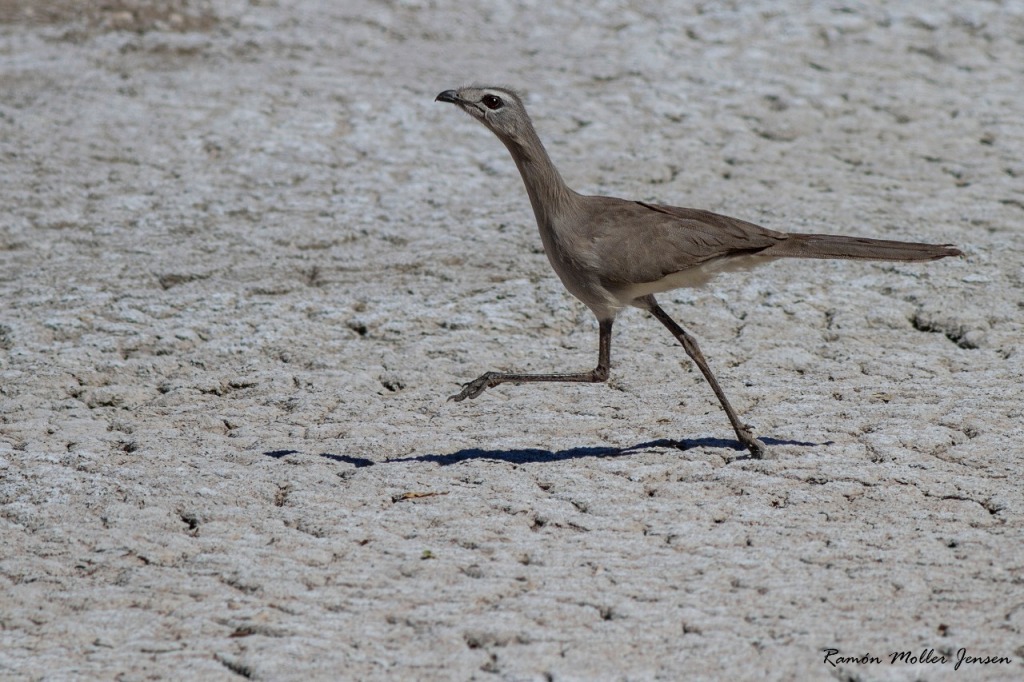
TAXONOMIA
Las discrepancias con las especies de rapaces también son taxonómicas, no solo a que orden pertenecen las especies de rapaces, también la definición de especies o subespecies. Estas discrepancias se ponen de manifiesto en las diferentes listas de verificación, las especies descritas por cada una de ellas varian. Entre las cuatro principales hay una diferencia de 52 especies entre la que más especies contempla y la que menos, en IOC World Bird Names (580 especies) las listas de HBW & Birdlife internacional (567 especies) y la ebird Clements (561 especies) y la Howard y Moore (528 especies). Una investigación publicada en 2020 analiza los desacuerdos taxonómicos de las distintas listas (McClure et al. 2020). Estos autores encontraron 665 conceptos taxonómicos de aves rapaces que son consideradas especies por al menos una de las listas existentes, las cuatro listas coinciden en el 68,1% de ellas (453 táxones), mientras que en el resto de especies hay algún desacuerdo. Solo el acuerdo sobre los tacones es unánime el los cathartiformes y en los Cariamidae; En Accipitriformes, en Pandionidae el desacuerdo es del 100% y en Accipitridae el desacuerdo es del 21,2%; en las Strigiformes en Tytonidae en el 79% y en Strigidae en el 42% de los conceptos taxonómicos; y en Falconiformes el 11,5% de las especies están en desacuerdo.
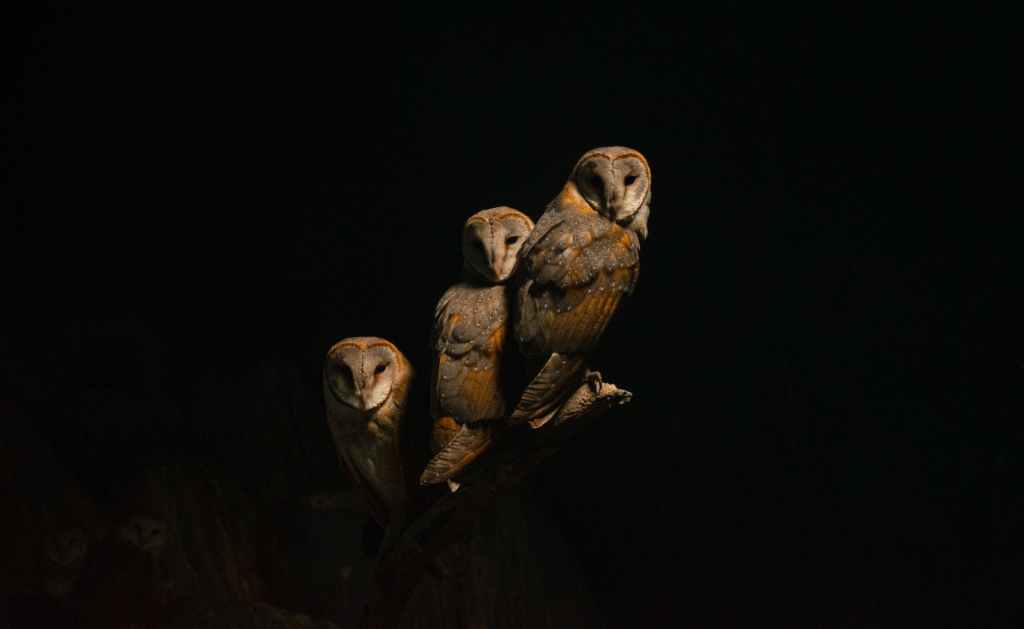
Estas diferencias taxonómicas también pueden tener una importante repercusión sobre la conservación de algunas especies en peligro, algunas especies de haberse considerado subespecies, su recuperación no hubiera sido prioritaria, esto ocurrió por ejemple en la década de los 80 con el águila imperial ibérica (Aquila adalberti), entonces era considerada como Aquila heliaca adalberti una subespecie del Aquila imperial (Aquila heliaca), estudios taxonómicos la consideraron como especie (González et al. 1989) y desde entonces los esfuerzos para su recuperación se incrementaron y su población comenzó a recuperarse.
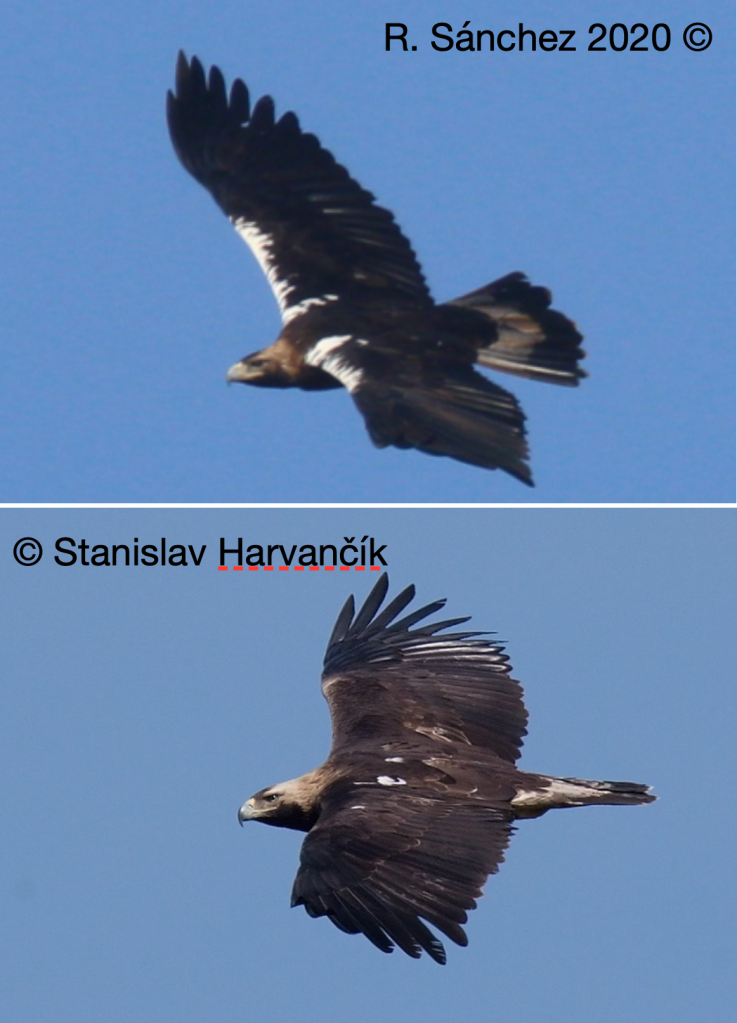
Initially, the characteristic spots of the white leading edge of wing of the Spanish Imperial Eagle (above) suggested that it was a different species than the Imperial Eagle (below), but the reproductive isolation was decisive for it to be considered a different species.
Imperial Eagle ( Macaulay Library ML228615861) © Stanislav Harvančík
Otras especies con la que actualmente existen dicrepancias actualmente son consideradas por la UICN como especies amenazadas, el Gavilán caguarero (Chondrohierax wilsonii) en la lista de HBW & Birdlife internacional y Howard y Moore la consideran especie, mientras que las listas de verificación IOC World Bird Names y ebird Clements, la consideran subespecie de Milano picogarfio (Chondrohierax uncinatus wilsonii), esta última especie esta considerada por la IUCN como especie de Preocupación menor (LC). Sin embargo él Gavilán caguarero esta considerado como especie en peligro critico (CR), su población esta estimada en menos de 250 ejemplares y todos los individuos se encuentran en el este de la isla de Cuba. Lo mismo ocurre con el Autillo de Annobon (Otus feae), un pequeño Búho de la Isla de Annobon frente a las costas de Gabon. Solo es reconocido como especie por HBW & Birdlife internacional, por el resto de listas es considerado subespecie de Autillo africano (Otus senegalensis feae), esta última especie esta catalogada por la IUCN como especie de preocupación menor (LC) mientras que la primera especie, el altillo de annobon esta catalogado como especie en peligro critico (CR), su población esta estimada en menos de 250 ejemplares y todos los ejemplares están en la pequeña isla de Annobon. Estas diferencias de criterio puede provocar problemas de conservación importantes, como la falta de recursos económicos para implementar planes de conservación, por ejemplo organizaciones norteamericanas que están empleando importantes recursos enfocados a la conservación de rapaces utilizan la lista de verificación de ebird Clements y no las consideran prioritarias. De hecho actualmente no se están implementando acciones encaminadas a la conservación de estas dos especies.
Los ejemplos mostrados en este escrito son claros ejemplos de la importancia de la definición de una especie es su conservación, para bien como ocurrió con el cóndor de california en USA y el Águila imperial ibérica en España, o para mal como le ocurre al Gavilán caguarero en Cuba y al Autillo de Annobon en la costa oeste africana.
Citar como / Cite as: Sánchez, R. 2021. Rapaces; definiciones y nuevas especies. Eagle News, Ecología y Conservación de las Rapaces entrada 62.
Raptors; definitions and new speciesEagle News, Ecology and Conservation of Raptors post 62.
Raptors; definitions and new species
The definition of what is considered a raptor can be a very important aspect for a species, this seems a matter of little importance, but when a species is critically endangered it can be decisive for its recovery or extinction. Many organizations only fund conservation programs aimed at protecting raptors. The same occurs when a Critically Endangered species is considered a subspecies of a species considered Least Concern. Here we will see examples of species that were recovered because they were considered raptors, or because they were not considered a subspecies. Taxonomy can be decisive for the conservation of a critically endangered species, since when a species belongs to the «raptors» it arouses greater social interest than when it is not.
The attention paid to the species considered as raptors is high, there are no established or reliable criteria to exclude or include a species from the group of raptors. The term raptor derives from the Latin «Rapt» which means «seize, carry off» in reference to the stereotypical raptor hunting strategy of seizing prey. The interest in correctly defining a raptor is growing, for years the taxa included in the orders of the Cathartiformes, Accipitriformes Strigiformes and Falconiformes have been considered raptors. Although with the Cathartiformes the debate was greater and some authors questioned them as birds of prey (Seibold and Helbig 1995, Tagliarini et al. 2011) and considered that they should be included in the order of the Ciconiiformes.
Raptors have often been defined in terms of their predatory diet based on live animals, although this designation alone was too confusing since it could include insectivorous passerines, gulls, or Shrikes (Lanius) that are predators and even carry prey with their feet (Pérez and Hobson 2007, Sustaita and Rubega 2014), so this definition is very generic and a more precise one is required. Some species of seabirds were also described as raptors, the Great Skua (Stercorarius skua) and the Parasitic Jaeger (Stercorarius parasiticus) due to their predatory lifestyle and sexual dimorphism, females are larger than males have also been considered. as raptors (Catry et al. 1999). However, as the definition of raptors is traditionally limited to terrestrial bird species, seabirds were excluded. Therefore, a raptorial lifestyle alone is not an exclusive or precise criterion for defining birds of prey (McClure et al. 2019). There are also several criteria based on morphology, for example Bronw (1976) stated, ‘‘True birds of prey are those which have powerful, taloned feet for grasping and killing, and hooked beaks for tearing flesh. ’’ For other authors, raptors are those with sharp eyesight to detect prey, feet with sharp claws to kill or hold and hook-shaped beaks to kill or consume prey (Brown 1971, Newton 1979, Bildstein 2017 in McClure et al. 2019).
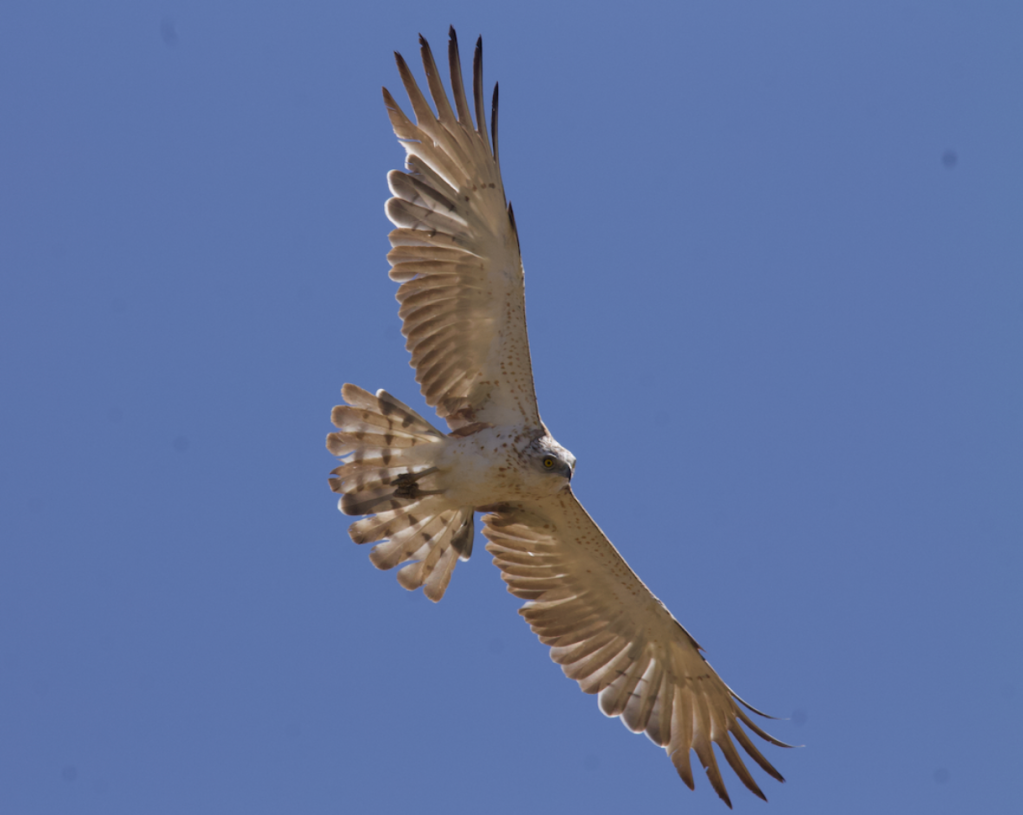
Short-toed Snake-Eagle (Circaetus gallicus) immature in flight, This species fits all the definitions made to describe a raptor. Photography: R. Sánchez 2015 ©
The visual acuity of raptors has been described by Newton (1979) and recently by Bildstein (2017) as an adaptation to hunting. In investigations that study the behavior of hunting and the hunting techniques used by some species of raptors, it was found that most of the techniques were based on observation, from perches or from the air (Margalida et al. 2017). Some of the Old World vulture species have the highest recorded visual acuity among vertebrates, for example the Eurasian Griffon (Gyps fulvus) which is capable of detecting small carrion at several kilometers (own data). The Spanisih Imperial Eagle (Aquila adalberti), it has been found that a territorial bird is capable of identifying an intruder at distances of between 5 and 6 kilometers and starting an attack from an innkeeper (own data). However, visual acuity is not typical of raptors, but also of other prey species, visual acuity can also be a defense mechanism for prey to defend against predators, therefore include visual acuity in the name of raptors is not a determining aspect.
On the legs, powerful and with large claws, most species have them, all species of Falconiformes and Striguiformes, however in the Accipitriformes, Sagittariidae lacks these characteristics and in Accipitridae the same happens to the vultures of the old world. On the contrary, there are other species of birds such as the Psittaciformes that, although they lack sharp nails with their feet, can hold food or other objects, the same happens with the Shrike (Lanius) that are capable of moving large prey with them, for this reason the definition for raptors of «feet with sharp claws for killing or holding prey» is also not entirely correct. Something similar happens with the beak, having a strong hook-shaped beak is not exclusive to raptors, ptittaciformes have beaks with these characteristics, the same occurs with shrikes (Lanius), on the contrary some species of raptors have their beaks They do not meet these characteristics, for example the old world vultures, the caracara or the secretary bird do not have hook-shaped beaks, but they do have strong and capable of chopping prey. However, other species such as crows (eg, Corvus corvus, C. corax, C. cryptoleucus), can feed on live prey and carrion and are included in their guide for surveying and monitoring raptors
Regarding “killing live prey”, it is traditionally believed that eagles are hunters and that they feed mainly on live prey and that they feed on carrion residually ”. When the feeding behavior of the Spanish Imperial Eagle (Aquila adalberti), a typical species of eagle, was studied, it was found that scavenging was used more frequently than expected and even that birds of non-breeding ages fed on carrion very frequently (Margalida et al. 2017), Something similar happened in Spain with the Golden Eagle (Aquila chrysaetos). Traps were placed on carrion and it was found that they accessed them to feed quite frequently (Sánchez-Zapata et al., 2010). There are also numerous species that meet the characteristics of «killing live prey» and without the scavenging behavior having been described, such as Shrike (Lanius), and species of this genus, although according to some authors could be included as raptors, are not among the fourth orders traditionally recognized as raptors.
The classification of vultures as raptors has also been a source of disagreement. The obligate scavenging behavior of many vultures and their lack of especially sharp talons differentiate them ecologically and morphologically from other birds of prey such as hawks, eagles, and owls (McClure et al. 2019). However, in recent years the reports of vultures killing live prey have increased, although an aberrational behavior is still considered and very possibly related to the scarcity of carrion. Similar behaviors have been described with Old World Vultures, the Andean Condor (Vultur gryphus), and the Black Vulture (Coragyps atratus). Although all these species are considered raptors.
The definition of what is considered a raptor, it is not a mere theoretical or academic fact, it can be decisive for the conservation of a species, for many organizations dedicated to the conservation of raptors it is important to be clear about which species are included, since their funds are specifically targeted at raptors. The California Condor (Gymnogyps californianus) is a clear example of this. It became extinct as a wild species and in 1987 all living condors were in captivity. Its decline was already evident throughout the 20th century, in 1950 its population was estimated at 150 individuals, in 1968 it was estimated at 60 birds, in 1978, 30 birds and during the first half of the 80s the rate accelerated. decrease (Finkelstein et al. 2020), and then it was decided to capture the few specimens that were still in freedom and were kept in captivity at the San Diego Zoo and the Los Angeles Zoo (California). Under these dramatic circumstances, the inclusion of the Cathartiformes as raptors was decisive to obtain financing and begin an ambitious recovery plan that ended up returning this emblematic species back to its natural environment, attempts to reintroduce it began in 1992 in California, Arizona in 1996 and in Baja California (Mexico) in 2002, currently it is reproduced in California and Arizona. The non-inclusion of the California Condor as a raptor would have caused its extinction as a wild species, possibly yes.
The last proposed definition for raptors or birds of prey is, as all species within orders that evolved from a raptorial land bird lineage and in which most species maintained their raptorial lifestyle as derived from their common ancestor (McClure et al. 2019) and based on the current taxonomy these authors propose that this definition include species of the orders Accipitriformes, Cathartiformes, Strigiformes, Cariamiformes and Falconiformes. Therefore, two more species of raptors and birds of prey would be included, the Red-legged Seriema (Cariama cristata) and the Black-legged Seriema (Chunga burmeisteri) both have their distribution range in South America and both species feed on small vertebrates, and morphologically superficially resemble Secretarybirds (Sagittarius serpentarius) in diet, behavior, and appearance so much that seriemas and secretary bird were once placed in the same order, so the secretary bird was included in the Cariamiformes.
The Red-legged Seriema (Cariama cristata) lives in open woodland, thorny scrub and hilly grassland. Its large size, bright red legs and bill, and prominent loose crest make it a visually distinctive species. Its distribution range is framed in the C&E Brazil through E Bolivia and Paraguay to Uruguay and C Argentina (S to La Pampa), it is a sedentary bird (Gonzaga et al 2020), it is classified as a species of least concern and the size of its population is unknown, its population trend is considered stable (Birdlife international 2016). It builds its nests on tree branches with branches, leaves and organic material, lays 2 to 3 eggs and the incubation is 30 days, and they leave the nest in 30 days. It bases its diet on the consumption of amphibians, snakes, rodents, and insects.
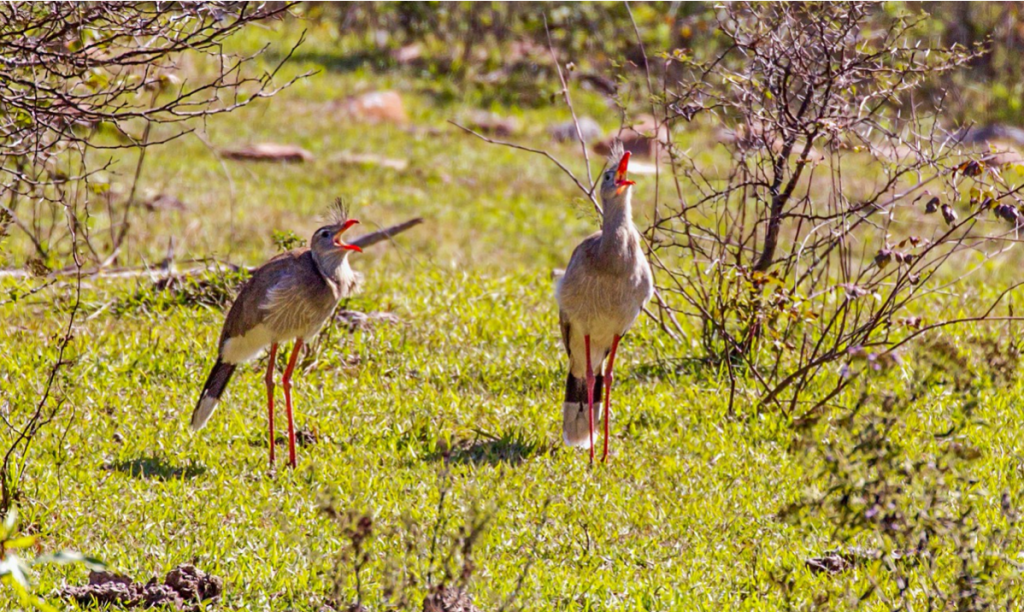
Black-legged Seriema (Chunga burmeisteri) is endemic to the Chaco region of central southern South America, in Bolivia, Argentina, and Paraguay. It has a terrestrial behavior and is not very flying, it lives in the wooded chaco, it is sedentary. It is classified as a species of least concern and the size of its population is unknown, its population trend is considered stable (Birdlife international 2016). It builds nests with branches on the low branches of trees or in bushes it lays 2 to 3 eggs, however only one chicken gets to fly, although there are reports of nests with 2 chickens, their diet is based on the consumption of lobsters, small snakes and small passerines (Gonzaga et al 2020).
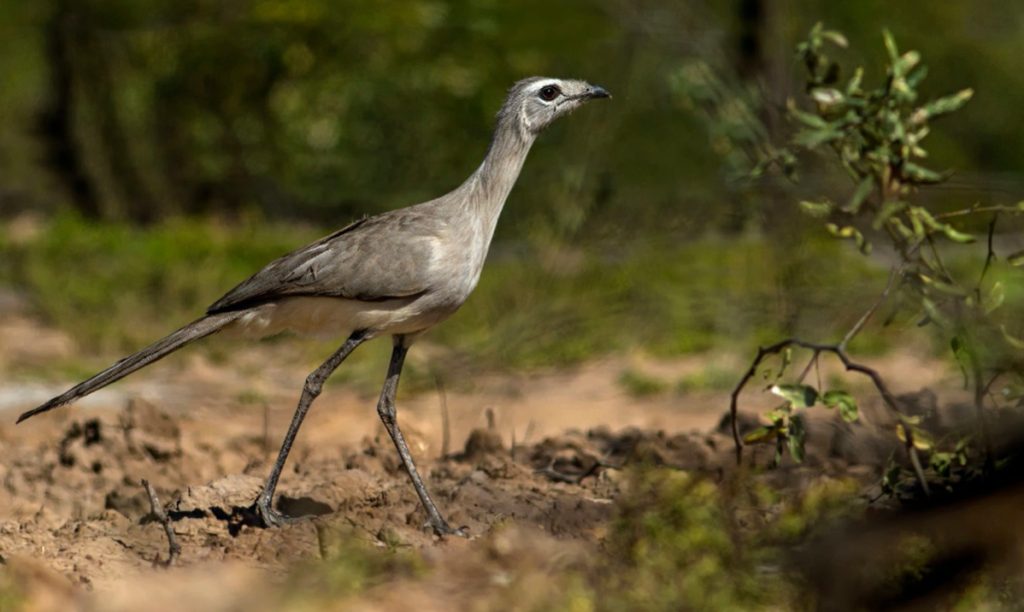
TAXONOMY
The discrepancies with the raptor species are also taxonomic, not only to what order the raptor species belong, but also the definition of species or subspecies. These discrepancies are revealed in the different checklists, the species described by each one of them vary. Among the main four there is a difference of 52 species between the one with the most species and the one with the least, in the IOC World Bird Names (580 species), the international HBW & Birdlife lists (567 species) and the ebird Clements (561 species) and the Howard and Moore (528 species). Research published in 2020 analyzes the taxonomic disagreements of the different lists (McClure et al. 2020). These authors found 665 taxonomic concepts of birds of prey that are considered species by at least one of the existing lists, the four lists coincide in 68.1% of them (453 taxa), while in the rest of the species there is some disagreement. Only the agreement on heels is unanimous in the cathartiformes and in the Cariamidae; In Accipitriformes, in Pandionidae the disagreement is 100% and in Accipitridae the disagreement is 21.2%; in Strigiformes in Tytonidae in 79% and in Strigidae in 42% of the taxonomic concepts; and in Falconiformes 11.5% of the species disagree.
These taxonomic differences can also have an important impact on the conservation of some endangered species, some species had been considered subspecies, their recovery would not have been a priority, this Tytonidae species have a high degree of disagreement in all the lists occurred for example in the 80s with the Iberian imperial eagle (Aquila adalberti), then it was considered as Aquila heliaca adalberti a subspecies of the Aquila
These taxonomic differences can also have an important i impact on the conservation of some endangered species, some species had been considered subspecies, their recovery would not have been a priority, this Tytonidae species have a high degree of disagreement in all the lists occurred for example in the 80s with the Iberian imperial eagle (Aquila adalberti), then it was considered as Aquila heliaca adalberti a subspecies of the Imperial Eagle (Aquila heliaca), taxonomic studies considered it as a species (González et al. 1989) and since then the efforts for its recovery have increased and its population began to recover.
Other species with which there are currently discrepancies are currently considered by the IUCN as threatened species, the Cuban Kite (Chondrohierax wilsonii) on the international HBW & Birdlife list and Howard and Moore consider it a species, while the IOC World Bird checklists Names and ebird Clements, consider it a subspecies of Hook-billed Kite (Chondrohierax uncinatus wilsonii), this last species is considered by the IUCN as a species of Least Concern (LC). However, the Cuban Kite is considered a critically endangered species (CR), its population is estimated at less than 250 specimens and all individuals are found in the east of the island of Cuba. The same goes for the Annobon Scops-owl (Otus feae), a small Owl from Annobon Island off the coast of Gabon. It is only recognized as a species by HBW & Birdlife international, for the rest of the lists it is considered a subspecies of African Scops-owl (Otus senegalensis feae), this last species is listed by the IUCN as a species of least concern (LC) while the first species, the annobon loft is listed as a critically endangered species (CR), its population is estimated at less than 250 specimens and all specimens are on the small island of Annobon. It is only recognized as a species by HBW & Birdlife international, for the rest of the lists it is considered a subspecies of African Scops-Owl (Otus senegalensis feae), this last species is listed by the IUCN as a species of least concern (LC) while the first species, the annobon loft is listed as a critically endangered species (CR), its population is estimated at less than 250 specimens and all specimens are on the small island of Annobon. These differences in criteria can cause important conservation problems, such as the lack of economic resources to implement conservation plans, for example North American organizations that are using important resources focused on the conservation of raptors use the ebird Clements checklist and do not consider them priority. Currently no actions are being implemented aimed at the conservation of these two species.
The examples shown in this writing are clear examples of the importance of the definition of a species is its conservation, for better as happened with the California Condor in the North America and the Spanish Imperial Eagle in Europe, or worse as it happens to the Cuban Kite in the Caribbean and the Annobon Scops-Owl on the west coast of Africa.
Bibliografia / Refrences
Bildstein, K. L. (2017). Raptors: The Curious Nature of Diurnal Birds of Prey. Cornell University Press, Ithaca, NY, USA.
BirdLife International. 2016. Cariama cristata. The IUCN Red List of Threatened Species 2016: e.T22692205A93341300. https://dx.doi.org/10.2305/IUCN.UK.2016-3.RLTS.T22692205A93341300.en. Downloaded on 15 January 2021.
BirdLife International. 2016. Chunga burmeisteri. The IUCN Red List of Threatened Species 2016: e.T22692208A93341490. https://dx.doi.org/10.2305/IUCN.UK.2016-3.RLTS.T22692208A93341490.en. Downloaded on 15 January 2021.
Brown, L. (1976). Aves rapaces: su biología y ecología. A&W Publishers, Inc., Nueva York, NY, EE. UU.
Catry, P., R. A. Phillips, and R. W. Furness (1999). Evolution of reversed sexual size dimorphism in skuas and jaegers. The Auk 116:158–168.
Finkelstein, M., Z. Kuspa, N. F. Snyder, and N. J. Schmitt (2020). California Condor (Gymnogyps californianus), version 1.0. In Birds of the World (P. G. Rodewald, Editor). Cornell Lab of Ornithology, Ithaca, NY, USA. https://doi.org/10.2173/bow.calcon.01.
Gonzaga, L. P. and G. M. Kirwan (2020). Red-legged Seriema (Cariama cristata), version 1.0. In Birds of the World (J. del Hoyo, A. Elliott, J. Sargatal, D. A. Christie, and E. de Juana, Editors). Cornell Lab of Ornithology, Ithaca, NY, USA. https://doi.org/10.2173/bow.relser1.01
Gonzaga, L. P., G. M. Kirwan, and E. de Juana (2020). Black-legged Seriema (Chunga burmeisteri), version 1.0. In Birds of the World (J. del Hoyo, A. Elliott, J. Sargatal, D. A. Christie, and E. de Juana, Editors). Cornell Lab of Ornithology, Ithaca, NY, USA. https://doi.org/10.2173/bow.bllser1.01
González, L. M., Hiraldo, F., Delibes, M., Calderón, J. (1989). Zoogeographic support to consider the Spanish Imperial Eagle as a distinct species. Bull. British Ornithological Club, 109: 86-93.
Margalida, A., Colomer, M., Sánchez, R., Sánchez, F. J., Oria, J., & González, L. M. (2017). Behavioral evidence of hunting and foraging techniques by a top predator suggests the importance of scavenging for preadults. Ecology and evolution, 7(12), 4192-4199.
McClure, C. J., Schulwitz, S. E., Anderson, D. L., Robinson, B. W., Mojica, E. K., Therrien, J. F., … & Johnson, J. (2019). Commentary: Defining Raptors and Birds of Prey. Journal of Raptor Research, 53(4), 419-430.
McClure, C. J., Lepage, D., Dunn, L., Anderson, D. L., Schulwitz, S. E., Camacho, L., & Johnson, J. (2020). Towards reconciliation of the four world bird lists: hotspots of disagreement in taxonomy of raptors. Proceedings of the Royal Society B, 287(1929), 20200683.
Newton, I. (1979). Population Ecology of Raptors. Buteo Books, Vermillion, SD, USA.
Pérez, G. E., and K. A. Hobson (2007). Feather deuterium measurements reveal origins of migratory western Loggerhead Shrikes (Lanius ludovicianus excubitorides) wintering in Mexico. Diversity and Distributions 13:166–171.
Sánchez-Zapata, J. A., Calvo, J. F., Carrete, M. A. R. T. I. N. A., & Martínez, J. E. (2000). Age and breeding success of a Golden Eagle Aquila chrysaetos population in southeastern Spain. Bird Study, 47(2), 235-237.
Seibold, I., and A. J. Helbig (1995). Evolutionary history of New and Old World vultures inferred from nucleotide sequences of the mitochondrial cytochrome b gene. Philosophical Transactions of the Royal Society B: Biological Sciences 350:163–178.
Sustaita, D., and M. A. Rubega (2014). The anatomy of a shrike bite: Bill shape and bite performance in Loggerhead Shrikes. Biological Journal of the Linnean Society 112:485–498.
Tagliarini, M. M., P. C. M. O’Brien, M. A. Ferguson-Smith, and E. H. C. de Oliveira (2011). Maintenance of syntenic groups between Cathartidae and Gallus gallus indicates symplesiomorphic karyotypes in New World vultures. Genetics and Molecular Biology 34:80–83.



14 Comentarios »